Distrackted
Registered
Here are some notes and pictures regarding a recent upgrade I did to my LGB 20271 "Heidi" locomotive. The project was reasonably straightforward, although as I am a bit old school and prefer switches to programming locks, I did have one issue.I ended up having to use three toggle switches, in addition to the factory "cab" switch to enable all three decoders (onboard, sound and smoke) to be programmed in isolation of the other two.
It turned out that since I was using simulation mode from the sound decoder to pulse the smoke, simply cutting off power to the sound decoder was not enough to isolate it. With power to the pulsed smoke generator on, and power to the sound decoder off, there was signal passing back through the simulation connection sufficient to "blip" the speaker connected to the sound card and cause all kinds of cv read errors from the smoke generator decoder.
Adding a switch to break the "simulated pulse" connection between the two solved the issue completely, and all the decoders could be read and written flawlessly. However, it wasn't enough just to interrupt the ground wire, which I thought would be sufficient! I also had to interrupt the signal wire. This required a double pole single throw switch adding further to the project complexity.
I wan't really happy with all the shiny switch levers sticking down below the frame, but covering them with black heat shrink went a long way to making them less obvious.
Removing the body from the frame on this locomotive is easy as all the screws are visible without removing the motor block and running gear. I was able to leave all the original pieces of the locomotive in place, simply drilling holes for sound in the boiler support plate, and in neat rows in the frame on either side of the mounting block.
Due to limitations to the allowed amount of test in a single post, I will put the detailed project description in a reply post.......
Here is the finished locomotive reassembled:
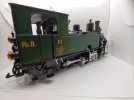
and here is a view of everything mounted in place (sound board and enclosed speaker - sorry no pictures of the round pulsed smoke generator in the smoke box):
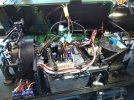
and another view of the items in place:
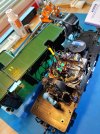
and here is a view of the holes drilled in the boiler support which was left in place:
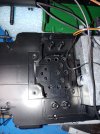
with the speaker and enclosure screwed in place:

here is the volume control mounted sideways on the inside of the frame with nylon hex standoffs:
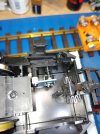
and a side-on view of the volume control knob:
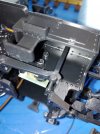
here is a view of how the reed switches were mounted in a diy protective sheath:

and another view with the reed switch board in place:

here is an inside-cab view of the two toggle switches required to fully isolate the smoke generator:
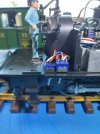
and a view of the same switches from below:
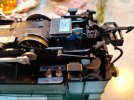
here is the inside=cab view of the toggle switch used to isolate the sound board:
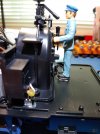
and a view of this switch from the underside:
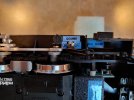
I
